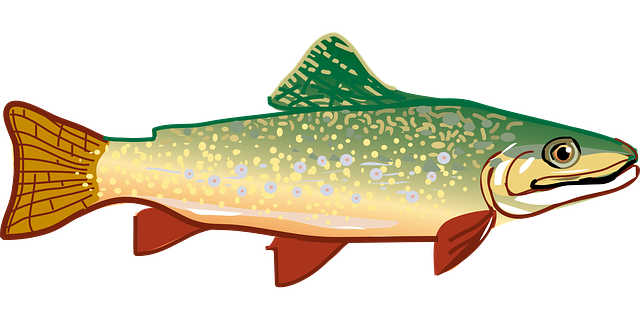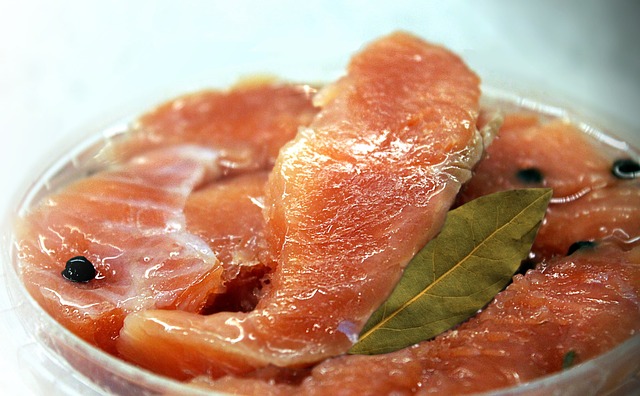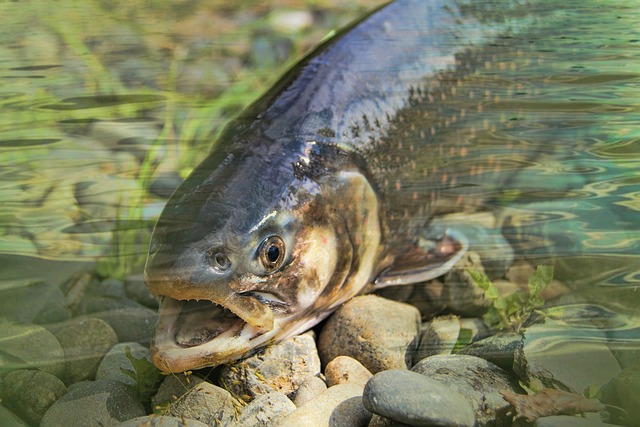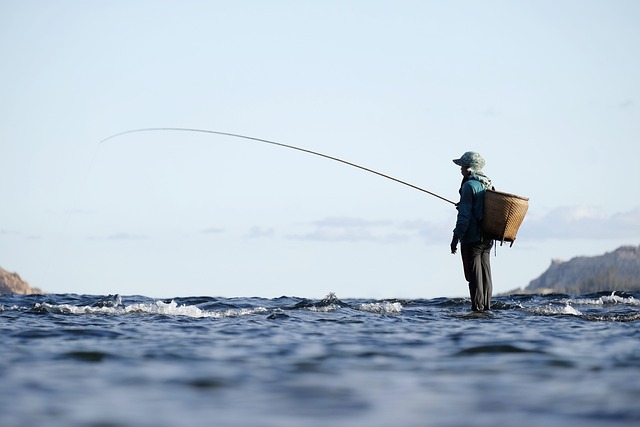To successfully catch river trout, anglers must adapt their fly fishing techniques to the local conditions and trout's behavior. Key tactics include mastering fly presentation, whether casting upstream and letting the current guide your fly, or using sinking leaders/sink-tip lines for deeper presentations and floating lines with indicators for shallower waters. The choice of fly should align with the predominant local food source, which could vary by season. Matching the hatch is a timeless trout fishing tip, and environmental factors like water clarity and light conditions can influence both fly selection and presentation style. Patience, skill, and an understanding of the fish's habits within their environment are essential. Additionally, observing river insect activity to select appropriate fly patterns and practicing casting to deliver a smooth, precise fly without spooking the trout are crucial for a successful catch. Always use gentle handling techniques with barbless hooks to ensure the well-being of the trout and adhere to sustainable fishing practices. By incorporating these tailored river trout fishing tips, you can enhance your experience and chances of catching trout.
Embark on a journey into the art of river trout fishing with our comprehensive guide designed to enhance your fly fishing skills. Discover masterful techniques tailored for trout in flowing waters and glean top trout fishing tips that promise to up your catch count. Whether you’re an experienced angler or new to the sport, this article will refine your approach to effectively land more trout on your next fly fishing expedition. Dive into the nuances of river trout behavior, learn effective casting methods, and unlock the secrets to successful trout fishing.
- Mastering Techniques for River Trout Fishing: Essential Strategies and Tactics
- Top Trout Fishing Tips for Catching More Fish on Your Next Fly Fishing Adventure
Mastering Techniques for River Trout Fishing: Essential Strategies and Tactics

When targeting river trout, anglers must adapt their techniques to the specific conditions of the waterway and the behavior of the fish. To effectively catch trout in a river, it’s crucial to understand the aquatic environment and how it influences trout movement and feeding patterns. Mastery of presentation is key; cast your fly just upstream of where the trout is likely to be holding, allowing the current to bring your lure to them naturally. Trout fishing tips such as presenting the fly at the correct depth are essential; use sinking leaders or sink-tip lines for deeper presentations, and floating lines with indicator techniques for shallow waters.
Choosing the right fly is another critical aspect of river trout fishing. Observe the surrounding environment to select a pattern that mimics the most prevalent food source at that time. Matching the hatch is an age-old trout fishing tip that remains relevant—imagine a fly that resembles what trout are feeding on, whether it’s an adult mayfly in the summer or a nymph burrowing in the gravel during warmer months. Additionally, be mindful of the water’s clarity and light conditions; sometimes, subtle presentations with subdued colors work best, while at other times, brighter flies might be necessary to catch the attention of wary trout. Catching trout effectively requires a blend of patience, skill, and an intimate understanding of both the fish and their habitat. With these river trout fishing strategies in your arsenal, you’ll be well-equipped to enhance your chances of a successful outing.
Top Trout Fishing Tips for Catching More Fish on Your Next Fly Fishing Adventure

When targeting river trout with a fly rod, understanding the behavior and habitat of these fish is crucial for success. Trout fishing tips that focus on matching the hatch can significantly increase your catch rate. Pay attention to the insects present in the river at the time of your visit; this will guide you in selecting the appropriate fly patterns. Observing the water’s surface can alert you to feeding activity, indicating which flies might be most effective. Additionally, casting with a smooth, accurate delivery is essential; practice casting techniques to ensure your line lands gently on the water without causing undue disturbance that could spook the trout.
Trout are often found in areas with optimal cover and oxygen levels, such as near river bends, undercut banks, and around submerged rocks or structures. Efficient river trout fishing requires stealthy approach and presentation of your fly in these strategic locations. Use a weighted fly to fish deeper runs where trout might be holding, especially on windy days. Tailoring your leader setup and fly selection to the specific conditions of the river will also enhance your ability to catch more trout. Always remember to handle any fish you catch with care, using barbless hooks to minimize harm and ensuring their safe release to contribute to sustainable trout fishing practices. With these trout fishing tips in mind, you’ll be well-equipped for a successful fly fishing adventure.
Anglers seeking to enhance their trout fishing experiences can benefit immensely from mastering the techniques outlined in “Mastering Techniques for River Trout Fishing: Essential Strategies and Tactics” and the top trout fishing tips provided in “Top Trout Fishing Tips for Catching More Fish on Your Next Fly Fishing Adventure.” These resources serve as a guide to effectively navigate river environments, understand trout behavior, and employ fly fishing methods that increase the chances of catching more trout. By applying these insights, both novice and seasoned anglers can savor the satisfaction of successfully reeling in river trout. Remember, patience, precision, and a willingness to learn are key components in becoming adept at trout fishing with a fly rod.



